Game Boy Gallery

- European release in April 1995
- Australian release in 1995
- Never released in North America
- Never released in Japan
- Developed by TOSE
There Was an Attempt

Game Boy Gallery is one of Nintendo’s most obscure game. For comparison, the company has released many kind-of unknown titles in Japan. Games that never saw translation nor rerelease. Titles whose only thing holding them back from being completely forgotten is the notoriety of Nintendo. The question then has to be asked, what makes Game Boy Gallery more obscure than games like Famicom Basic? Because it was only released in Europe and Australia, and people confuse it for its sequel. But wait a minute, everybody knows about Game & Watch Gallery!
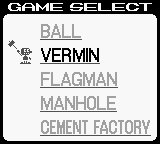 Game Boy Gallery
Game Boy Gallery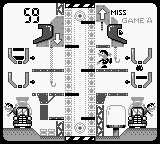 Game & Watch Gallery
Game & Watch GalleryGame & Watch Gallery is the sequel to Game Boy Gallery, made right after and released worldwide. Game & Watch Gallery was a much better game which beautifully adapted the Game & Watch toys on Game Boy. The original game we are talking about here, Game Boy Gallery, was the first attempt to bring the Game & Watch toys of Nintendo R&D1 to Game Boy. For its crazy release history and attempt at repackaging an iconic Nintendo toy line, it’s essential.
One final note: the strange release of the game made every major market use a different naming scheme for the games. I have a handy table to show you those differences.
| Japan | North America | Europe | Australia |
|---|
| Not released | Not released | Game Boy Gallery | Game Boy Gallery |
| Game Boy Gallery | Game & Watch Gallery | Game & Watch Gallery | Game Boy Gallery 2 |
| Game Boy Gallery 2 | Game & Watch Gallery 2 | Game & Watch Gallery 2 | Game Boy Gallery 3 |
| Game Boy Gallery 3 | Game & Watch Gallery 3 | Game & Watch Gallery 3 | Game Boy Gallery 4 |
| Not Released | Game & Watch Gallery 4 | Game & Watch Gallery Advance | Game & Watch Gallery Advance |
Not as crazy as the Crazy Castle series, but it’s still convoluted for no good reason.
The Game & Watch Part
I previously talked about the Game & Watch series of portable electronic toys in my Super Mario Land article. Game & Watch was a series of portable electronic games all made with pocket calculator technology down to the most important component; the display of the Game & Watch toys are segmented LCD crystals just like on a calculator. They were single purpose toys by design and created by R&D1, Gunpei Yokoi’s division at Nintendo. While today LCD games like the Game & Watch are synonymous with cheap crap, when they were initially conceived in the early ’80s, they were incredible. Partly because they were a brand new idea, but mostly because they were made by the genius designers at Nintendo; they poured their heart and soul into those little toys and so their gameplay is delightful. They ooze quality and attention. Do keep in mind that I have never actually played a real Game & Watch. The closest I have been to a real one is pica-pic.com which features Flash (unfortunately) versions that you can play on your browser.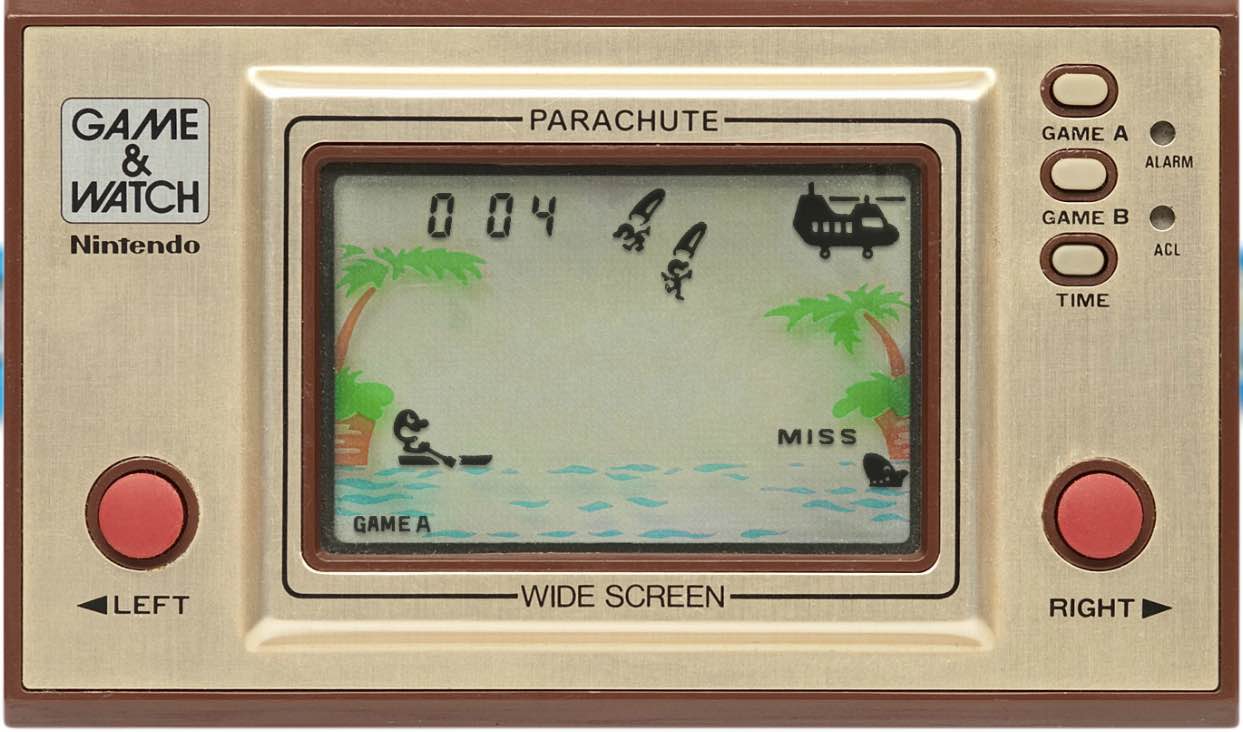
They were reportedly very popular in Japan but had a hard time leaving a mark in the North American market. I serendipitously had one much older cousin tell me that she had one when I was a kid. What was the reason she told me? I was playing Game & Watch Gallery 2 next to her. That is the extent of my experience with the original hardware. I guess most people in North America had a similar experience; they maybe knew someone who owned one at one point. Because of this lack of success in North America, the Game & Watch is often forgotten as a formative experience for Nintendo. Before Ball in 1980, Nintendo was not having much success with their electronic consoles. Their Japanese Pong clones weren’t exactly flying off the shelves. There were simply too many competitors. With Ball and the succeeding Game & Watch games, Nintendo had a seemingly evergreen video game success. They could just pump out game after game after game and they would sell. This obviously showed Hiroshi Yamauchi, Nintendo’s president and ruthlessness in human form, that the real money in video games was with a repeat business. This helps me understand why Nintendo got out of the arcade business so quickly. Arcade cabinet sales are hit-driven; it doesn’t matter what company name is written on the side of the cab, if the game’s not a success arcade operators will not buy more than one. But Game & Watch showed that in the consumer market if you could build a brand that people equated with quality they would spend again and again. You could build trust with direct consumers. That’s what Nintendo had with the Game & Watch. People knew Game & Watch toys were fun because the initial concept of basing a video game on calculator technology was solid and Nintendo’s R&D1 game design was unparalleled. All of Nintendo’s competitor in the LCD games market didn’t pay as much attention to detail. This constant innovation (for example, the D-Pad was invented for the Game & Watch version of Donkey Kong) gave Nintendo a 10 years head start on portable game design experience. They used that experience to inform the design of the Game Boy, absolutely, but it surely had a lot of influence on the Famicom and all their home consoles. Game & Watch was the perfect marriage of a toy with electronics, and the Famicom and all of Nintendo’s consoles, portable or not, carry that ideal as well. I’d argue that the Game & Watch toys, not the Famicom or their hit arcade titles, transformed obscure little toy maker Nintendo into video game behemoth NINTENDO.
With an impact this big on Nintendo’s identity, it’s no wonder that in 1995 they started trying to honour it on Game Boy. If you want to see this impact firsthand, go read the Iwata asks about the recreated Ball Nintendo made for Club Nintendo members.
The Boy Part
Game Boy Gallery is a collection of five Game & Watch toys, the early classics of the electronic toy line:
 Ball
Ball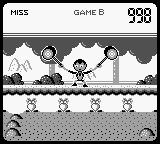 Vermin
Vermin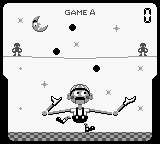 Flagman
Flagman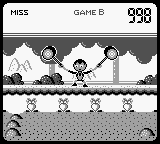 Manhole
Manhole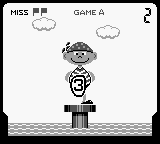 Cement Factory (which dropped the Mario part)
Cement Factory (which dropped the Mario part)I’m not going to go into details; the games are the definition of plug-and-play so if you want to understand what they’re all about, you should play them. They’re also a tough nut to crack for me: since I’ve never played an original Game & Watch, I cannot vouch for those reproduced experiences. I do not know if the timing, the patterns, and the controls are exact or approximations. And if I don’t get my hands on an original Game & Watch for any of these five titles, I can’t speak to their faithfulness. What I can say is that the pixel graphics really clash with the stiff, position-to-position gameplay you see in these games. The reproductions of the original graphics in the Game & Watch Gallery games telegraph much better the position-to-position gameplay of a Game & Watch.
Unfortunately, original Game & Watch toys are now prohibitively expensive. Those things were not meant to last more than a couple of years and the few that survived through the decades now command an incredible premium. I guess it teaches an important lesson: if you’re interested in collecting for monetary gains, you should collect the flimsy stuff that’s going to break immediately but that people will need for their rudderless writing endeavours decades later.
To get back to the games at hand, let’s not walk around the bush: they’re not great. You will realistically play each game for a couple of minutes, figure out what it’s about and move on. You might not even get to a couple of minutes with Flagman, which is just Simon.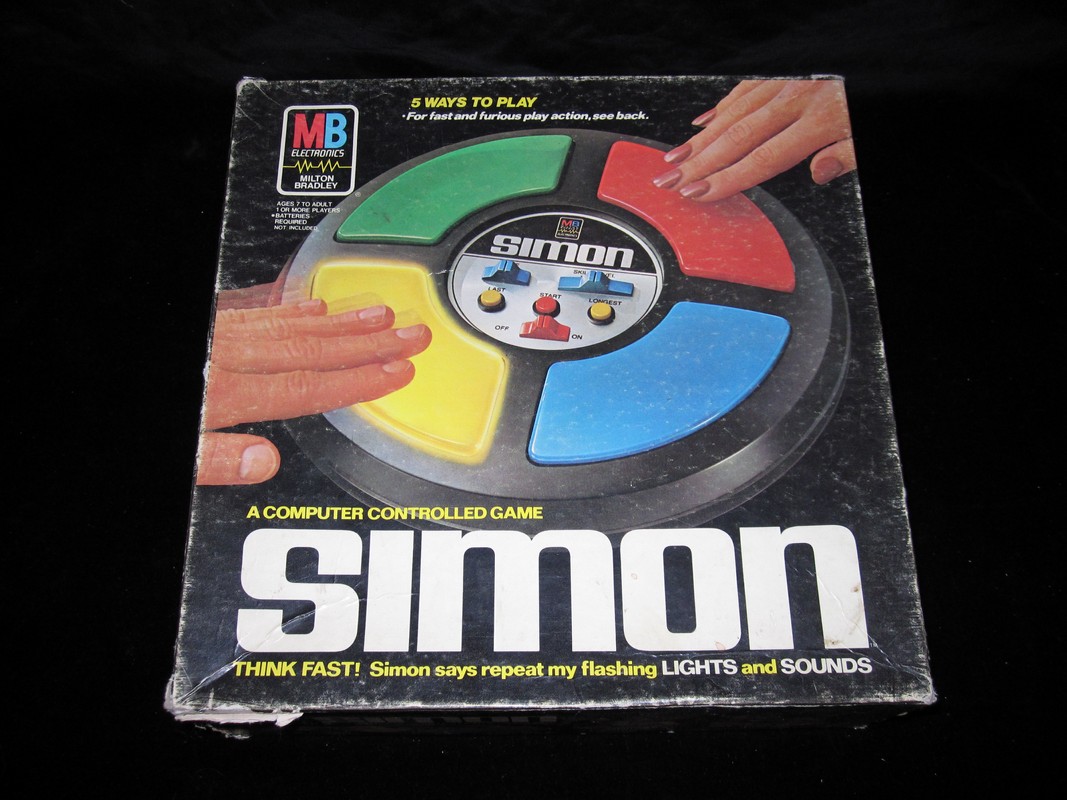 Simon, the pattern-matching game
Simon, the pattern-matching game
There seems to be some confusion online that you can unlock more games to play. That is not the case. They seem to be confusing the few unlockable games of the sequels, and the museum sections where you can see the action (without being able to play yourself) of some Game & Watch titles. But there’s nothing of the sort here. Game Boy Gallery has no unlockable content. That’s fascinating to me. People write authoritatively about what you can unlock without having the energy to play enough of the game to realize they’re getting confused with another game. That’s how boring Game Boy Gallery is.
But one thing about the game that is not boring are the graphics. They’re very ugly, but they’re interesting nonetheless. The game got rid of Mario for Cement Factory and Mr. Game & Watch for all the other games and instead used a creepy-looking dude as your avatar. Why would Nintendo decide not to use Mr. Game & Watch and Mario? I think it comes down to two things. First, and this one’s a theory of mine, it’s very possible the creepy dude is supposed to be Mr. Game & Watch. He’s just very poorly done. Second, the game was developed by TOSE, which was probably not trusted with Mario. This makes it a great opportunity to talk about the most mysterious developer in the world: TOSE.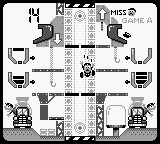 On Super Game Boy, the graphics really look nicer. Even though the borders are incorrect. Flagman did not have left and right buttons, for example.
On Super Game Boy, the graphics really look nicer. Even though the borders are incorrect. Flagman did not have left and right buttons, for example.
TOSE
What is TOSE? They’re a mysterious Japanese video game developer renown for how unknown they are. It’s weird but it’s true. They’re usually subcontracted by a publisher, or even a developer, to make a game on the down-low. They will help make the whole thing if needed. Hiring a developer to help out is absolutely normal; the crazy thing is TOSE are never credited for their work, except on rare occasions. The Columbos of the video game world have found ways to confirm a game was made by them, be it quarterly reports, interviews or even by finding clues in the source code of games. And here’s the craziest part about them; there is no lack of games they worked on. They are ubiquitous. Digging a bit on their website, they sell themselves to potential clients by claiming they’re the most prolific video game developer in the world:
Although we are not permitted to reveal specific titles due to confidentiality agreements with customers, we have the most extensive track record in the industry with approximately 1,000 home video game software titles.
Isn’t that crazy? They claim they’re the most prolific developer in the world and they are probably right! The biggest video game developer in volume is a gun-for-hire developer that goes uncredited in almost all their work. But they’re not exactly a bad developer pumping out bad game after bad game. The best description of their work ethic comes from Jeremy Parish. He called them something like a chameleon developer. If you want a thrash video game done quickly, they’re your developer. If you need their help with the development of a console’s most intricate, most involved game (Metal Gear: Ghost Babel), they’ll provide. But they’ll only give you the work you ask them to do. They’ll do nothing more. So the more detailed your design is, the better TOSE will perform. Knowing the way they work, and what they did with Game Boy Gallery, Nintendo of Europe probably had the idea of bringing over some old Game & Watch games to the Game Boy and figured that TOSE was perfect for the job. Nintendo could simply give them the mission of bringing over the Game & Watch titles they wanted. The gameplay design was already done over a decade ago, there was no extra work needed on that front. Nintendo could use TOSE very efficiently to bring the classic Game & Watch gameplay to Game Boy. I’m oversimplifying here; I’m sure they had involved conversations about the music, the graphics, how to implement the controls, etc. But the most complicated, risky part of any game’s development, its gameplay, all that work had already been taken care of in the early ’80s when they made the toys.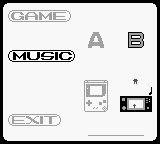 This option screen would be further expanded and become the main attraction of future Game & Watch Gallery titles
This option screen would be further expanded and become the main attraction of future Game & Watch Gallery titles
But all that work on the part of Nintendo was clearly not enough; TOSE gave them a mixed bag. The game is competent but extremely shallow. You can choose between original Game & Watch sounds only or add some music; the melodies are strictly useless fluff. There’s also a disconnect between the graphical details and the simplicity of the gameplay. I totally commend the people at Nintendo for not abandoning the concept at this point; it is not immediately clear that you could do something better out of Game & Watch games on Game Boy than the mediocrity that is Game Boy Gallery.
The Release
I’ve already mentioned it, but here it is again: the release of the game is a part of what makes it essential. The game was released in Europe in April of 1995 and in Australia somewhere in 1995 as well. Let’s talk about Australia first.
I read a tiny bit about Nintendo in Australia and came up even more bewildered than before: Nintendo in Australia had to align their console releases with Europe, since the island nation used PAL as its TV standard. This meant Australia could wait years before they got a game. Nintendo would usually release a game in Japan, have it localized for North America, then have it adapted for PAL and SECAM in Europe and localized at the same time to the multiple languages of Western Europe. Then and only then Australia could pick it up for release. Even though they didn’t need all the localizations Europe was doing, they needed the PAL conversion, so they had to wait. This meant they were often the last market to receive a game. With the Game Boy, the story was different. Since they didn’t have to wait for a PAL conversion, Nintendo in Australia tended to align itself with North American releases; they only needed to wait for the localizations. This did not always mean that game got released there any earlier; Nintendo in Australia seemed to be accustomed to taking their time in bringing games to the island. This did not also mean that Australia always aligned itself with North America for portable games; Game Boy Gallery is a perfect example of Nintendo in Australia picking up a game from the European market.
We’ve discussed Australia, but the question remains; why was Game Boy Gallery released in Europe? The reflex is to think Nintendo in Europe is just the afterthought of the United States. The reality is more complex. In the ’80s and ’90s, Nintendo of Europe had to deal with multiple languages and a fragmented market with fiercer competition than in North America. And that’s without talking about the elephant in the room: PAL. While this website is dedicated to a console that is unaffected by different broadcast standards used with televisions, it’s important to note that it does have an impact on Game Boy: a positive one. When porting a game from the NTSC standard used in Japan and North America, compromises are bound to happen. Slower games, different colours, a game that was not conceived with PAL conversion in mind would not be the same in Europe. And the process was not turnkey; efforts had to be spent reprogramming a game minimizing the timing differences. This meant that for Nintendo, the Game Boy was a wonderful product. The Game Boy was cheap and thus much more affordable in countries with weak currencies. Its games had to be localized, sure, but that’s only if they needed to be localized at all. Tetris or Super Mario Land 2: Six Golden Coins, for example, do not have a lot of text. So the Game Boy was a vital element of Nintendo’s European endeavours. Which is why we see Nintendo of Europe doing its own thing in Europe. They weren’t strictly following in the footsteps of Nintendo of America. They published Japanese games in Europe that never saw any release in North America, like Boulder Dash, Adventures of Lolo and Lucle. They also released Magnetic Soccer, a Nintendo published game that was only released in Europe. Game Boy Gallery fits right in with the rest of those projects. Keep in mind that Game Boy Gallery was overseen by a Japanese Nintendo employee: Matsuoka Hirofumi. What I’m arguing here is that the people at Nintendo of Europe were probably the one who wanted the game; the people at Nintendo in Japan were the ones making it.
Conclusion
Game Boy Gallery was a very barebones game released in 1995. Game & Watch Gallery by comparison has lavish production values and was released in 1997. What happened in between the release of those two games? The 1996 Japanese release of Pokémon, of course.
Instead of releasing their collaboration with TOSE in their two most important markets, they went back to the drawing board and spent way more time building a better concept. Game & Watch Gallery was the result, a much better game marrying both faithful recreations of Game & Watch toys and modern interpretations with updated gameplay and graphics. I absolutely believe that the lavish treatment given to Game & Watch Gallery was a consequence of Pokémon’s Japanese release. It made Nintendo pay more attention to the Game Boy.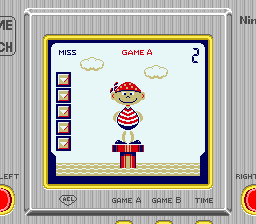 Or maybe, just maybe, the people at Nintendo got one look at the character TOSE had created for the game and said no to Mr. Creepy Marionnette.
Or maybe, just maybe, the people at Nintendo got one look at the character TOSE had created for the game and said no to Mr. Creepy Marionnette.
This article was first published on the .
This article was last modified on the .